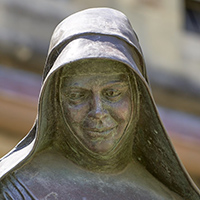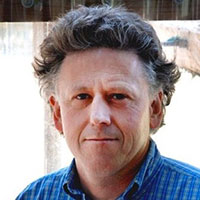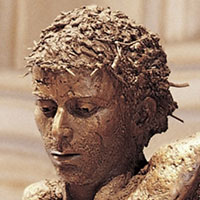 The Sydney Modern is the new building of the Art Gallery of New South Wales opened at the end of 2022, located between the old building and the botanical gardens. Its glass-fronted foyers are open and spacious, offering perspectives on Sydney Harbour.
The Sydney Modern is the new building of the Art Gallery of New South Wales opened at the end of 2022, located between the old building and the botanical gardens. Its glass-fronted foyers are open and spacious, offering perspectives on Sydney Harbour.
Continue reading “WELCOME SCULPTURE for Hospitality and Inclusion”

 In the course of history, sculptors have played a key role in representing, immortalising and honouring those who have helped shape the national, sporting, religious or cultural identity of a country. In Australia, one of the most popular and prolific creators of public sculpture is Melbourne-based Louis Laumen. Professional artist since 1995, Laumen has received over fifty commissions for bronze statues of sporting or war-time heroes and popular public figures, as well as a large number of religious works.
In the course of history, sculptors have played a key role in representing, immortalising and honouring those who have helped shape the national, sporting, religious or cultural identity of a country. In Australia, one of the most popular and prolific creators of public sculpture is Melbourne-based Louis Laumen. Professional artist since 1995, Laumen has received over fifty commissions for bronze statues of sporting or war-time heroes and popular public figures, as well as a large number of religious works.  Over the last twenty-five years, Australian artist, Ron Mueck (b. 1958), has become well-known for his hyper-realistic sculptures, generally of the human figure either much larger or smaller than life size. Every hair is painstakingly inserted in an eyebrow or a stubbly beard. Whether it is an enormous boy or pregnant woman, whether it is a miniature image of his dead father laid out naked, the sculptures create a sense of awe, wonder and contemplation in the viewer.
Over the last twenty-five years, Australian artist, Ron Mueck (b. 1958), has become well-known for his hyper-realistic sculptures, generally of the human figure either much larger or smaller than life size. Every hair is painstakingly inserted in an eyebrow or a stubbly beard. Whether it is an enormous boy or pregnant woman, whether it is a miniature image of his dead father laid out naked, the sculptures create a sense of awe, wonder and contemplation in the viewer.  by Luke Jerram
by Luke Jerram This figure of the pregnant Mary, carved and painted by George Mung Mung (c1920–1991), is a significant work of Christian art and devotion that reflects the merging of Catholic and Aboriginal communities and systems of belief in Australia.
This figure of the pregnant Mary, carved and painted by George Mung Mung (c1920–1991), is a significant work of Christian art and devotion that reflects the merging of Catholic and Aboriginal communities and systems of belief in Australia.  The Australian sculptor, Thomas Dwyer Bass am, was born in Lithgow in 1916. After various jobs during the Depression and army service during WWII, he began his career as a sculptor on graduating from the National Art School in 1948. Prior to the war, Bass attended Dattilo Rubbo’s art school; it was here he was initiated into the principles of art. At the National Art School he came under the influence of Lyndon Dadswell whose assistant he became during 1949-1950. This was followed by a three-year stint of teaching there. From 1951-1964 he held various executive positions with the Sculptors’ Society, of which he was a founding member.
The Australian sculptor, Thomas Dwyer Bass am, was born in Lithgow in 1916. After various jobs during the Depression and army service during WWII, he began his career as a sculptor on graduating from the National Art School in 1948. Prior to the war, Bass attended Dattilo Rubbo’s art school; it was here he was initiated into the principles of art. At the National Art School he came under the influence of Lyndon Dadswell whose assistant he became during 1949-1950. This was followed by a three-year stint of teaching there. From 1951-1964 he held various executive positions with the Sculptors’ Society, of which he was a founding member.  The bronze sculptures of Judith Rolevink at St Francis Xavier Cathedral, Adelaide.
The bronze sculptures of Judith Rolevink at St Francis Xavier Cathedral, Adelaide. The Power of Touch
The Power of Touch The Cathedral of St Stephen in Brisbane holds the best collection of the work of Australian sculptor, John Elliott (1943-2016). Nowhere else are there three major works together. The cathedral has the shrine of Virgin Mary, the altar crucifix and the diocesan shrine of patron St Mary MacKillop. John Elliott was born in Canterbury, England, studied at the Royal College of Art in London, and migrated to Australia in 1970. He taught sculpture at the Queensland College of Art.
The Cathedral of St Stephen in Brisbane holds the best collection of the work of Australian sculptor, John Elliott (1943-2016). Nowhere else are there three major works together. The cathedral has the shrine of Virgin Mary, the altar crucifix and the diocesan shrine of patron St Mary MacKillop. John Elliott was born in Canterbury, England, studied at the Royal College of Art in London, and migrated to Australia in 1970. He taught sculpture at the Queensland College of Art.  Pauline Clayton worked as a sculptor in Melbourne and her works are featured in various institutions, including St Francis’ Church, Lonsdale Street, and schools, including Catholic Ladies College, Eltham. In addition to juggling the responsibilities of marriage, helping to raise three children and teaching, Pauline undertook art classes at the Royal Melbourne Institute of Technology (RMIT) and taught art and sculpture in secondary schools, including Geoghegan College, Broadmeadows and Genazzano fcj College, Kew, VIC.
Pauline Clayton worked as a sculptor in Melbourne and her works are featured in various institutions, including St Francis’ Church, Lonsdale Street, and schools, including Catholic Ladies College, Eltham. In addition to juggling the responsibilities of marriage, helping to raise three children and teaching, Pauline undertook art classes at the Royal Melbourne Institute of Technology (RMIT) and taught art and sculpture in secondary schools, including Geoghegan College, Broadmeadows and Genazzano fcj College, Kew, VIC.